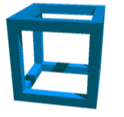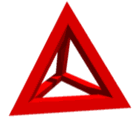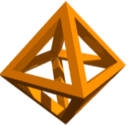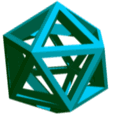At some point, when your children have become used to the idea of regular and irregular shapes (as described on the page about regular shapes) they will probably start to talk about solid objects: boxes, balls, and various containers. This is the opportunity to introduce the idea of geometrical solids, pointing out that in many cases a solid object has regular shapes on some edges: for instance, a cylindrical tube has a circle at each end.This page describes and demonstrates the only five completely regular solids: those which are made up of identical faces.
The five regular ‘Platonic’ geometrical solids

This is a cube, the most commonly seen of the regular solids. Dice used in board games are this shape, which is made up of six squares. Some boxes are cubes, although the majority have at least some rectangular sides, which makes them cuboids, or rectangular prisms. A cube is a regular cuboid where every edge is the same length.
A cube can also be known as a hexahedron. When the first part of a word starts with ‘hex‘ it is nearly always related to the Greek word for ‘six’. A hexagon is a flat shape with six sides, and a hexahedron is a solid with six faces.

This is a tetrahedron, the simplest of the regular solids. It’s made up of four equilateral triangles. The prefix ‘tetra‘ is the Greek word for ‘four’. A more common (but not regular) solid is the pyramid, which consists of four equilateral triangles and a square base.

This is an octohedron. It’s made up of eight equilateral triangles. The prefix ‘octo‘ is the Greek word for ‘eight’ – it’s also found in the word octopus (a creature with eight legs). An octohedron can be thought of as two pyramids with their square bases stuck together.

This is an icosahedron. It’s made up of twenty equilateral triangles. The prefix ‘icosa‘ is from the Greek word ‘eikosi‘ meaning ‘twenty’. It’s not something that’s seen very often and is quite complex to make.

This is a dodecahedron. It’s made up of twelve regular pentagons. The prefix ‘dodeca‘ is the Greek word meaning ‘twelve’. While there are not many dodecahedrons in everyday life, the structure makes a good basis for a child’s soft ball, consisting of pentagons sewn together to make this kind of shape.
If you want to use them on another site, please include a link to their site.
If you would like to know about flat shapes – such as the squares, triangles and pentagons that make up the above solids, see the page on geometric shapes.
For more articles about teaching basic maths without workbooks or drill, see:
Number bonds – beginning addition
Beginning multiplication
Prime numbers and factors
Algebra for six-year-olds